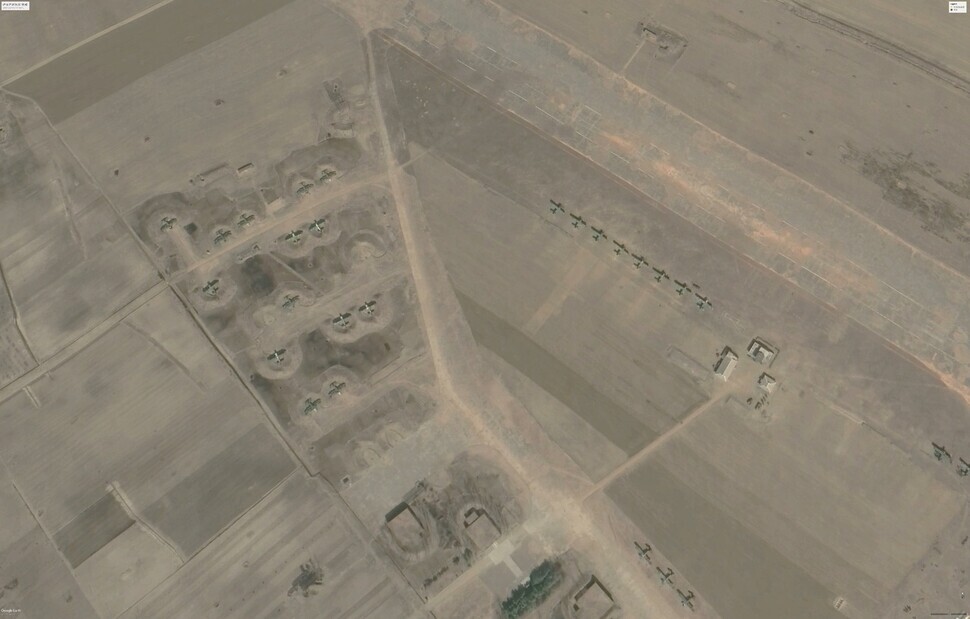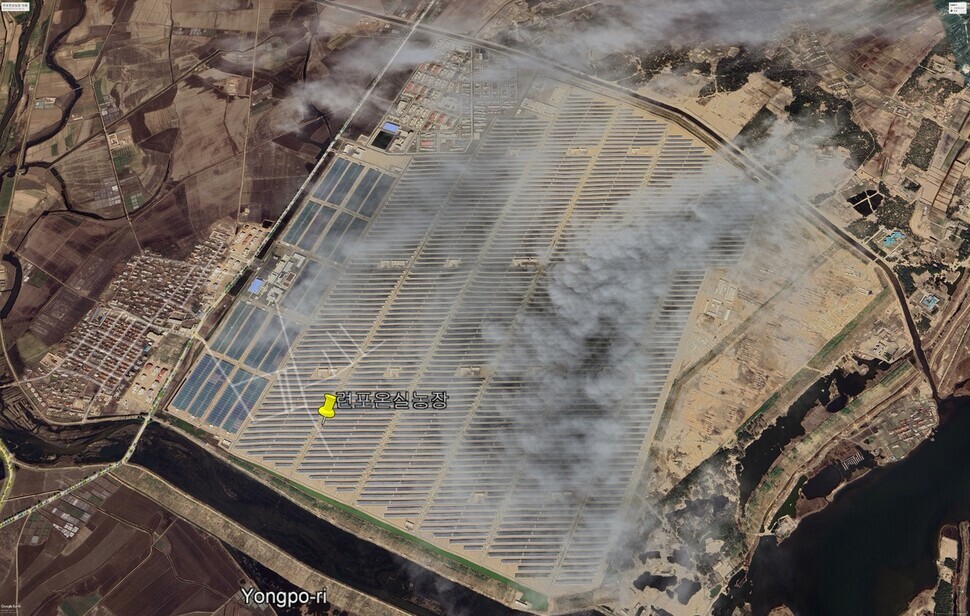hankyoreh
Links to other country sites 다른 나라 사이트 링크
Behind bellicose bluster, N. Korea is turning airfields into greenhouse farms

The mood on the Korean Peninsula has been fraught since the very start of 2024. Does North Korea really intend to start a war? Are we facing the prospect of a nuclear war in the region this year?
First, there were the predictions of a “spring crisis” that floated around South Korea like specters. The speculation was that South Korea might create a crisis to be used for political ends. Lending weight to these predictions were the actions of the Yoon Suk-yeol administration, which was thrusting inter-Korean relations deeper into an emergency with strong shows of antagonism toward the North.
Previously, the administration had included a passage in its first defense white paper in February 2023 stating that “the North Korean regime and military are our enemy.” The crisis predictions were bolstered further by its suspension of the comprehensive military agreement reached by the two sides on Sept. 19, 2018.
To make matters worse, National Defense Minister Shin Won-sik’s threats of “swift, forceful and definitive” action if North Korea further provokes South Korea, and military leaders’ support of such claims, have heightened tensions even further.
Fears that South Korea’s leadership in Yongsan will touch off a crisis have been adding to concern that spring winds may bring crisis to the Korean Peninsula.

A fitting example of the construction of a new socialist countryside
It was around this time that speculations about North Korea being ready to go to war began to emerge in the US. The hypothesis was spearheaded by Robert Carlin and Siegfried Hecker, two scholars affiliated with the Middlebury Institute of International Studies at Monterey.
Known as proponents of negotiation with North Korea, the scholars submitted to US-based North Korea news and analysis website 38 North that proved both shocking and provocative. “We believe that, like his grandfather in 1950, Kim Jong-un has made a strategic decision to go to war,” they wrote.
Robert Gallucci, a former US State Department special representative and a key figure behind the negotiations made between North Korea and the US after the first North Korean nuclear crisis in the 1990s, also bolstered their claims, stating, “We should at least entertain the thought that nuclear war could break out in Northeast Asia in 2024.”
This signified the shift in responsibility: instead of the crisis being instigated by South Korea, people began to think that North Korea might be the one to make the first move.
North Korean leader Kim Jong-un’s statements also bolstered such claims. While conducting inspections of major munitions factories in early January, he declared that “the ROK clan is our principal enemy,” and that “we will have no hesitation in annihilating the ROK by mobilizing all means and forces in our hands.”
At a speech made at a Supreme People’s Assembly meeting held on Jan. 15, Kim stressed that South Korea should be defined as North Korea’s “primary foe and invariable principal enemy” in its constitution.
“We can specify in our constitution the issue of completely occupying, subjugating and reclaiming the ROK and annex[ing] it as a part of the territory of our Republic in case [. . .] a war breaks out on the Korean Peninsula,” he argued.

The dismissal of age-old rhetoric that those from North and South Korea are fellow countrymen to instead adopt the stance stating that South Korea signifies hostile forces is only fueling anxieties over the possibility that North Korea may start a war.
So, is North Korea really serious about war? While it may seem like a non sequitur, in order to find an answer to that question we should take a look at certain facilities the North has been enthusiastically building: greenhouse farms.
In 2015, the Jangchon Vegetable Co-op Farm was built in Pyongyang. It is a massive greenhouse complex with 665 greenhouses on an area of about 684,000 square meters, where the North uses soil and hydroponic growing methods to cultivate tomatoes, peppers, eggplants and more.
To support the application of scientific methods in vegetable farming, the farm is equipped with a complete greenhouse monitoring system that allows farmers to control the temperature and humidity of the greenhouses. Some greenhouses are also equipped with solar water heaters and nanomaterial decomposers.
This is why the North is touting this facility as a fitting example of the construction of a new socialist countryside.
While it is impossible to completely verify this claim, North Korea seems to be pleased with the achievements brought by the greenhouse. Since then, larger, more technologically advanced smart farm complexes have been built in areas outside of Pyongyang.
The Jungphyong Vegetable Greenhouse Farm, which has 320 greenhouses, was built in North Hamgyong Province in 2019, and Ryonpho Greenhouse Farm, which boasts 852 greenhouses, was built in South Hamgyong Province in 2022.
Ground was broken for a farm of an even bigger scale dubbed the Kangdong Greenhouse Farm, on the outskirts of Pyongyang in early 2023.
Out of all of those co-op farms, Ryonpho Greenhouse Farm is said to have greenhouses that have been modernized, intensified, and industrialized on 280 hectares.
One can use Google Earth to see the large greenhouse complex at coordinates 39°47’33.3”N latitude and 127°31’59.1”E. If we are to estimate the size of the complex by examining the Google Earth satellite images, we can say that it is approximately 2.64 square kilometers (1.43 km × 1.85 km, 264 hectares), which is close to the number that North Korea uses to describe the site: 280 hectares (278 acres).
This demonstrates that the greenhouse complex is substantially large, at almost the size of Seoul’s Yeouido business district, putting it on a qualitatively different level from the past greenhouses built in North Korea, when South Korean support organizations provided all the materials needed for their construction, such as plastic sheeting.

Behind Kim Jong-un’s threats
At the ground-breaking ceremony for the construction of Ryonpho Greenhouse Farm in February 2022, Kim Jong-un emphasized the Workers’ Party of Korea Central Committee’s duty to “accelerate the overall rural development of the country more powerfully and confidently with it as a standard and torch.”
On Oct. 10, 2022, Kim attended the Ryonpho Greenhouse Farm’s ribbon-cutting ceremony instead of staying in Pyongyang for the anniversary of the founding of the Workers’ Party of Korea, demonstrating the farm’s importance.
More than a year later, in December 2023, the state-run Rodong Sinmun reported that the country had exceeded the 2023 plans for crop production.
The outlet explained that the completion of a smart integrated production system, adoption of cylindrical farming machines, and multi-layered farming helped increase vegetable yield while also lowering costs.
While it isn’t too hard to check the location and scale of these greenhouse farms with Google Earth, there are fewer external measures that we can utilize to verify how the greenhouse farms are being operated.
Nonetheless, we would be making hasty generalizations if we were to dismiss these claims as mere propaganda.
If these claims were being made for the sake of propaganda, building the Jangchon Vegetable Co-op Farm would have been more than sufficient.
However, the country has built much larger greenhouse complexes in the provinces and plans to continue to add more, with the goal of having one in each province.
Moreover, earlier this year, Kim Jong-un announced the “regional development 20 x 10 policy,” pledging to build manufacturing facilities in 20 cities and counties every year, substantially raising the standard of living in every city and county in the country within 10 years.
It is also worth noting that the recently constructed greenhouse complexes used to be military airfields.
If you utilize Google Earth’s historical imagery feature, you can see runways and airplanes waiting in the vicinity. Ryonpho Greenhouse Farm was built on the site of Ryonpho Airfield, which was still in use until 2022.
The Jungphyong Vegetable Greenhouse Farm was also built in 2018 by pushing out a military airfield in the Junphyong area in Kyongsong County, North Hamgyong Province. The Kangdong Greenhouse Farm in the suburbs of Pyongyang, which began construction in 2023, is also being built on another ex-airfield site, as confirmed by Yonhap News.
These economic activities provide a material basis for understanding Kim’s comments.
If North Korea is seriously pursuing reunification through force by starting a war, it is highly contradictory for the country to build such a large greenhouse complex at this certain point in time.
Furthermore, the fact that North Korea is demolishing its air force airfields one by one to make way for more greenhouse complexes can hardly be seen as preparation for reunification through war.
Kim is making these threats so that South Korea won’t mess with North Korea. As of now, he wants to focus on making economic progress, but if the Yoon Suk-yeol administration dares to start provoking him, he will not hesitate to retaliate mercilessly.
Korean relations are the relations “between two states hostile to each other,” and since the North no longer considers the South to be their countrymen, they will have no qualms resorting to use of nuclear weapons.
Therefore, the view that North Korea will instigate war is the same as the view that South Korea will be the one to take the first step toward war.
By Suh Jae-jung, professor of political science and international relations at the International Christian University in Tokyo
Please direct questions or comments to [english@hani.co.kr]

Editorial・opinion
![[Column] Season 2 of special prosecutor probe may be coming to Korea soon [Column] Season 2 of special prosecutor probe may be coming to Korea soon](https://flexible.img.hani.co.kr/flexible/normal/500/300/imgdb/original/2024/0426/3317141030699447.jpg) [Column] Season 2 of special prosecutor probe may be coming to Korea soon
[Column] Season 2 of special prosecutor probe may be coming to Korea soon![[Column] Park Geun-hye déjà vu in Yoon Suk-yeol [Column] Park Geun-hye déjà vu in Yoon Suk-yeol](https://flexible.img.hani.co.kr/flexible/normal/500/300/imgdb/original/2024/0424/651713945113788.jpg) [Column] Park Geun-hye déjà vu in Yoon Suk-yeol
[Column] Park Geun-hye déjà vu in Yoon Suk-yeol- [Editorial] New weight of N. Korea’s nuclear threats makes dialogue all the more urgent
- [Guest essay] The real reason Korea’s new right wants to dub Rhee a founding father
- [Column] ‘Choson’: Is it time we start referring to N. Korea in its own terms?
- [Editorial] Japan’s rewriting of history with Korea has gone too far
- [Column] The president’s questionable capacity for dialogue
- [Column] Are chaebol firms just pizza pies for families to divvy up as they please?
- [Column] Has Korea, too, crossed the Rubicon on China?
- [Correspondent’s column] In Japan’s alliance with US, echoes of its past alliances with UK
Most viewed articles
- 1Is Japan about to snatch control of Line messenger from Korea’s Naver?
- 2Up-and-coming Indonesian group StarBe spills what it learned during K-pop training in Seoul
- 3‘We must say no’: Seoul defense chief on Korean, USFK involvement in hypothetical Taiwan crisis
- 4[News analysis] Using lure of fame, K-entertainment agency bigwigs sexually prey on young trainees
- 5[Column] Park Geun-hye déjà vu in Yoon Suk-yeol
- 6Is N. Korea threatening to test nukes in response to possible new US-led sanctions body?
- 7Korea’s 1.3% growth in Q1 signals ‘textbook’ return to growth, says government
- 8Division commander ordered troops to enter raging flood waters before Marine died, survivor says
- 9Report reveals toxic pollution at numerous USFK bases
- 10[Editorial] Statue should not be central concern of comfort women issue